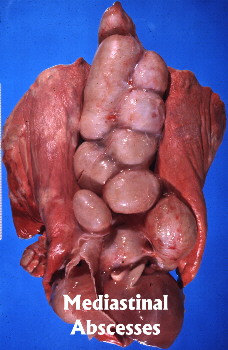Caseous Lymphadenitis
Caseous Lymphadenitis (CLA) can be a devastating disease for the sheep and goat producer. It can pose a huge economic loss by decreasing pelt value through abscess scars or, with the internal form, a loss through decreased weight gain and general unthriftiness, poor wool harvest or poor milk production. The internal form of the disease has been reported as the third most important cause of condemnation of sheep carcasses in the U.S. Eradication and control of the disease in a flock is of utmost importance. Efforts should be made to eradicate or control rather than treatment of infected individuals. Infection should be considered lifelong even if an animal appears to be non-symptomatic.
CLA is caused by the bacteria Corynebacterium pseudotuberculosis, which can survive in the environment for months to years. Infection with this organism causes two forms of the disease. Superficial CLA involves the lymph nodes just under the skin. It presents as an abscess or multiple abscesses which can be found around the head and neck or at the junction of the legs and body. These lesions will eventually rupture and drain. The second form, visceral CLA, involves the lymph nodes and organs found in the body cavity, especially the kidney and liver. Infected animals become debilitated, with poor weight gain, lower wool yield and decreased milk production. While both sheep and goats can have either form of the disease, goats tend to get the superficial form more commonly and sheep usually present with the visceral form. Animals less than six months old are less likely to have the disease than older animals. It is thought that this is due to repeated exposure to the organism throughout an animal's life. Infection should be considered lifelong. Infected animals should be eliminated.

Even though there are no cases of humans being infected with this disease in the U.S., there is always the potential. Cases have occurred in other countries, although these are generally found to be from hand skinning carcasses. Usually the person has injured their hand with an infected knife. Other cases were caused by consumption of raw infected milk. Because of this potential, handling of the body parts of infected animals and especially the pus from abscesses should never be taken lightly.
There is no reliable test method available to determine if the disease exists within a herd free of superficial CLA (abscesses). Abscesses can be cultured with an acceptable result for confirmation of the disease. A vaccination program aids in preventing the spread of the disease within an infected herd. The toxoid vaccine does not prevent the disease but reduces the amount of abscesses in infected animals thus reducing the volume of the bacteria shed. An autogenous vaccine can be produced specific to your herd as well. The vaccination program should be tailored to your specific entity.
As mentioned before, control and eradication of CLA are the most important goals for the producer with infected animals. The bacteria can infect animals through skin abrasions or punctures. Because of its ability to infect animals so readily, there are many things for the producer to keep in mind to protect healthy animals. Remove infected animals from the rest of the herd to prevent spreading the disease. Shear infected animals last, and youngest animals first. Do not open abscesses. Disinfect any area (feeders, waterers, etc.) that an infected animal may have used or where an abscess has drained. Minimize crowding to decrease spread to non-infected animals by seemingly uninfected herd mates. When buying new animals, make sure they come from CLA-free herds. Control external parasites and have the shearing crew use only the equipment from your farm. By keeping these things in mind, producers will be able to keep CLA from decreasing their economic gains.
Prepared by Cleon V. Kimberling, Gerilyn A. Parsons, Jay Parsons, Wayne Cunningham, Steve Sharkey, Steve Davis, and Kevin Inman
Optimal Livestock Services, LLC
970-231-2477
Copyright © 2013 CleonsCorner.com All Rights Reserved
